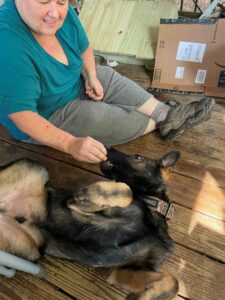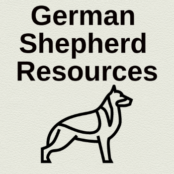
Welcoming a German Shepherd puppy into your home is a blend of joy, excitement, and a touch of apprehension. Known for their loyalty, intelligence, and unmatched work ethic, German Shepherds are a popular choice for a family pet. However, their strong-willed nature demands a focused approach to training, especially in the formative puppy years. In this comprehensive guide, we’ll walk you through the ins and outs of disciplining a German Shepherd puppy, ensuring they become the well-behaved, loving companion you’ve always imagined.
Table of Contents
The German Shepherd: A Breed Apart
Before disciplining a German Shepherd, understanding their innate traits is vital. These dogs were initially bred for herding, a job that required intelligence, agility, and a strong sense of responsibility. Today, these qualities translate into a dog that not only craves a role but also excels with proper training and engagement. German Shepherds are highly trainable, which is a blessing if approached correctly, but can become challenging if their needs aren’t met from the start.
The Cruciality of Early Training
Training should commence the moment your new family member steps into your life. Early socialization and obedience are not just tools for good behavior; they’re crucial for shaping your puppy’s worldview. This preparatory work is the foundation upon which a disciplined, social, and congenial adult dog is built.
Key Training Tips Every Shepherd Owner Should Know
First Fous on Your Bond
When you first bring your puppy home, plan to spend time with him. Building the bond is the main focus of the early weeks. This means have a plan and work your plan. When I bought my German Shepherd puppy, Jasper, home these are the things I wanted to focus on:
- Teaching him to go in his crate using treats, and slowly extending the time he was in there
- Teaching him to “wait” at the door of his crate for permission to come out
- Teaching him to wait at every entry way and exit, including the car door, for permission to exit
- Teaching him to wait for permission to eat from his bowl
- Teaching him to redirect his sharp little teeth onto a toy or chewy
- Teaching him to potty outside on command
- Teaching him not to jump up on me or anyone else
- Acclimating him to a collar and a leash gently
- Teaching him simple positions and tricks using luring and from a place of play not formal training
All these things, I simply worked into our day together, using short 5 minute “play” sessions and opportunities that just presented themselves as we went about our day. I did no “formal” training until he went to his first puppy class at 4 months. I approached everything as play during this time.
Socialization and Obedience Training
German Shepherds are sometimes aloof with strangers, which can turn into over-protectiveness without proper socialization. Introduce your puppy to various people, animals, and environments during the critical window of 3 to 14 weeks of age. Obedience training should follow closely, teaching basic commands such as sit, stay, and come which will form the vocabulary you use to communicate expectations.
Implement Positive Reinforcement
Nothing motivates a German Shepherd more than praise, play, and treats. Positive reinforcement fosters trust and strengthens the bond. This approach not only makes training more fun for your pup but also cements your status as a fair and kind leader. Positive reinforcement and redirection can be used successfully for 90% of training. With a young puppy, it is all you should use, other than a firm verbal no when needed. This is actually much kinder than a mother dog will be with her pups. If you watch a mother dog, she has no problem correcting her pups with nip and growls. So don’t be worried, you will scar your pup with a firm no. Pups like children need boundaries.
Routine is Queen
Shepherds thrive on a consistent schedule. Mealtimes, potty breaks, training times, and rest should follow a predictable pattern. Not only does this minimize accidents and behavioral issues but it also provides the structure that these intelligent dogs crave. 90% of your initial training issues can be resolved by having your pup either crated or on a house line when you are not directly interacting with him. However, this is a breed that needs exercise and interaction, so be sure you are providing for that need.
Command Consistency is King
Use clear and consistent commands and cues. Changing up your words or signals will only confuse your puppy and slow down progress. Everyone in the household must be on the same page with the training language.
The Importance of Exercise and Mental Stimulation
German Shepherds are high-energy and require both physical and mental challenges. Insufficient stimulation can lead to destructive behaviors. Regular walks, play, and dog sports can help drain their physical energy, while puzzles and training games will keep their minds sharp. They need this daily.
Pitfalls to Avoid
While training your German Shepherd puppy, steer clear of certain pitfalls. Never resort to harsh punishment, as it can lead to fear and aggression. Additionally, don’t neglect the training once the basic commands are mastered. Continuous learning and engagement will ensure a well-disciplined dog throughout their life.
Jasper’s Success Story
Jasper was 8 weeks old when I brought him home. If I had to categorize his basic personality, I’d say he was a medium drive puppy from a very high drive working line pedigree. Unlike some German Shepherds, Jasper was cuddly and basically sweet natured. I had researched a lot and had a clear idea of how to teach him the things I thought vital for a new puppy.
Potty training was a breeze. He was making it through the night by four months without needed to go out. He took quickly to going into his crate and was waiting to come out for permission. He quickly learned to sit and wait for permission to eat. It took a little longer to get him used to reining in that puppy enthusiasm at doorways, but he did learn. He learned tricks and commands with ease. In fact, I’ve had many dogs, but Jasper is by far the smartest dog I’ve ever had. Jasper was 90% trained in basic obedience, all with just positive reinforcement.
However, by 8 months he was strong enough to pull me over if he got excited by something like another dog. He wasn’t “trying” to hurt me. He just entered a state of hyperarousal (think fight or flight) and followed his nose so to speak and down I went. I tried various collars to no avail. I felt our interaction was becoming more negative than positive over this issue and my choices were to stop taking him out or seek help.
I believe it may be possible to slowly desensitize a dog like Jasper, but I’m not sure a 5’3″ 65 year old woman would survive the process. I took him to board and train, where he was acclimated to a stimulation collar by a professional trainer.
People have strong opinions about stimulation collars, but it has resolved that issue and allows me to go anywhere I want with Jasper safely. For Jasper and me, it was a good choice. At this point, no stimulation is needed. Just the sound is enough to redirect him, which is what a stim collar is for when used right. Redirection. It’s not to be used as punishment.
Unfortunately, my goal of doing dog sports with Jasper is on hold for now, as stim collars are not allowed and in that high stimulation environment I’d never take him without one right now. Maybe some day.
Parting Thoughts and Next Steps
Every training session is an investment in the rich relationship you’ll share with your German Shepherd. Start early, be consistent, and always remember to enjoy the process. For more guidance or to share your training triumphs, look for a welcoming German Shepherd community and continue discovering the joys of canine companionship.

